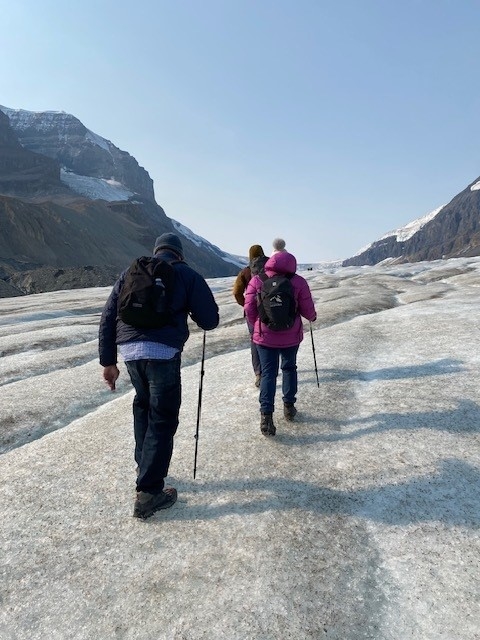One of the most impressive sites to see in the Canadian Rockies are the beautiful glaciers! However, these dense masses of ice are rapidly melting away and is one of our greatest and most pressing challenges. Why do glaciers matter to our world visitors?
First, how do glaciers form? Glaciers are found on mountaintops, which are usually much colder than the valleys around them. Snow that fell in the winter may not all melt away in summer, where more snow will fall on top of it the next winter. The snow accumulation will become heavier and heavier, compressing into what is called firn, like little ice pellets, and then into a dense mass of ice, a glacier. A good rule of thumb is that for a mountain to have a glacier, it must be at least 3000m/10,000’ in elevation to have cold enough temperatures for snow to persist year-round.
Of the 78 glacier-based water systems in the world, the top four seeing the fastest melt rate are the Himalayas, the Andes in South America, the European Alps, and here in the Canadian Rockies. Globally, over 1.9 billion people rely on mountain snow and ice to replenish their rivers, lakes and groundwater to support ecosystems, agriculture, energy, industry and drinking water. Last summer, communities in Alberta had water restrictions due to less snow the previous winter in the mountains upstream. Where mountains are our water towers, glaciers are water in the bank, our interest rate is falling, and our principal is disappearing far faster than imagined. To ensure reliable water supply and guarantee food security, glaciers are vaults of deep knowledge about the history of our planet and keep our planet cool, like a big refrigerator!
With our guests, we often visit the Athabasca Glacier and see many glaciers en route. We can go on the Ice Explorer or on a guided icewalk onto the Athabasca Glacier! This is life changing for many, to experience and understand what is happening to this glacier, which is part of the Columbia Icefield, a high plateau icesheet that is 220sq. km/137sq. miles.
2025 has been designated by the United Nations as the International Year of Glaciers’ Preservation, where the aim is to bring local, national and international attention to the importance of acting now to slow the pace of glacier melting. Groups like Guardians of the Ice, a local non-profit, is engaging people into wanting to reduce their carbon footprint and support our climate future. In January, Guardians launched a photo exhibit of the Columbia Icefield called MELTDOWN at the Whyte Museum in Banff. There are 30 digitally crisp, large-scale photos (up to 1.5m/5’ x 3m/10’), hoping to evoke an emotional impact for viewers to participate to take action. This exhibit will be at the Whyte Museum until April 13, 2025 https://www.meltdownphotography.com/exhibit, then migrate to the Glacier Galley in the Icefield Centre at the Athabasca Glacier, where it will be in residence for three years.
Let history record that 2025 was the tipping point where humanity changed course to eventually save the glaciers, ourselves and our planet!
Kristi Beetch
ACMG Hiking and Winter Travel Guide
IGA Master and Professional Interpreter
Guardians of the Ice Team